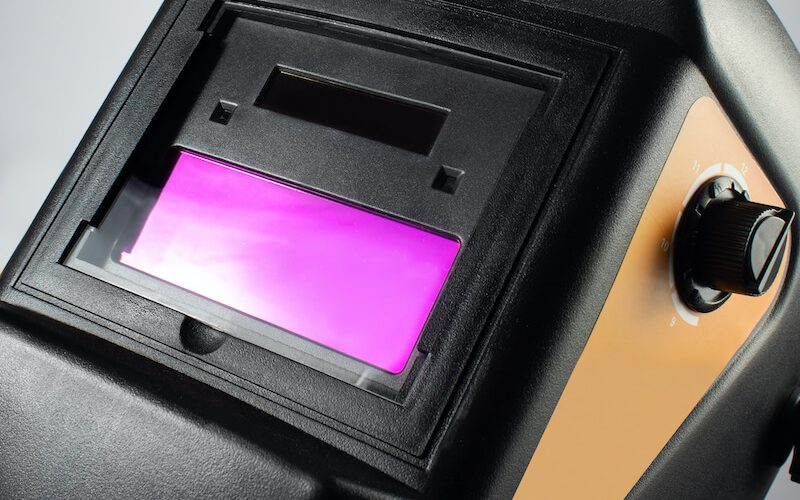Welding is like riding a bike; you never forget how to do it, and you better wear a helmet or mom’s gonna get mad.
If you’re reading this you’ve probably already made the decision to find the best welding helmet for your needs, so congratulations.
Safety is the number one concern when welding and the helmet is your first line of defense.
The only thing that’s left is to decide if it’s going to be a passive or an auto-darkening helmet…
Don’t worry; once you’re done reading this post, you’ll know which one is right for you.
The first welding helmet that I ever owned was a passive lens helmet. It had a tiny flip-up window, was very box-like, extremely uncomfortable – and cheap, the clincher for the broke college student I was back then.
It was probably the best helmet I could have started my career with because almost anything else would be way better.
I consider myself fortunate to have started welding on a passive lens and not an auto-darkening filter (ADF) – I grew confident and skillful in my welding abilities very quickly and formed a certain awareness of the joint and electrode, an almost subconscious connection.
Over the next decade, I worked as a welder in the military, various levels of government, and in most major industries, from aerospace to oil and mining. During all that time I went through many, many helmets.
Today I’ll present to you my conclusions regarding the passive vs auto-darkening decision.
Auto-Darkening Helmets
The ADF (Auto-Darkening Filter) is made up of a specialized liquid-crystal display, similar to that of a TV screen.
It’s either solar-powered, rechargeable battery-powered or a combination of both.
The lens is usually a number 3 or 4 shade when inactive, which is clear and easy to see through, but once activated, sensors positioned on the helmet (known as arc sensors) detect the changes of light in the environment and reduce the ADF shade when needed.
The more advanced arc sensors are able to differentiate between natural light, light-bulbs, and the welding arc – and only reduce the lens shade when needed.
ADFs have several advantages, namely:
- Higher-quality welds, no need to reposition the torch, and fewer bad starts resulting from the reduced head “nodding”, allowing the welder to stay focused.
- Welding in tight spots is much easier as the helmet does not need to be raised.
- Reduced neck discomfort if doing tack welding or other “abrupt” welds.
- Arc flashes are rare, mainly resulting from issues with the ADF delay settings. With passive helmets, the constant raising and lowering of the helmet can lead to getting flashed due to bad timing or if the arc strikes before the helmet is fully lowered.
The disadvantage of a fixed-shade ADF is that you’re generally stuck with a shade 10 darkness while welding and a shade 3 or 4 darkness when not welding, while even a passive helmet has the ability to swap out lenses to any shade needed.
These days there are many good auto-darkening welding helmets on the market at affordable prices.
Passive Welding Helmets
These helmets are fitted with a fixed-shade (usually #10), standard glass viewing lens, which is coated with UV (ultraviolet), and IF (infrared) protection. The process of welding with these helmets involves nodding the helmet up and down to be able to inspect the weld puddle and reposition the torch between welds.
Passive helmets have several advantages, namely:
- They are usually much cheaper than their auto-darkening counterparts.
- They are lightweight and pretty comfortable, unless you’re tack welding or constantly nodding the helmet up and down, in which case you will feel some neck discomfort.
- Usually more optically clear than ADFs.
- Lenses are easily and cheaply replaced, and it’s possible to purchase lenses with different shades and simply swap them out when needed.
- No need for batteries, sensitivity controls, or anything extra. It’s just you and the helmet.
Unless you really only need a single shade, I would not recommend a fixed-shade helmet.
In Summary
In the end, it all comes down to your individual needs. If you’re doing GTAW and SMAW, where you need good hand control when starting the arc, then ADFs are the way to go.
Remember that an inspector can and will fail a weld for excessive arc strikes, so if you don’t have the hand control SMAW requires, get an ADF.
On the other hand, if you’re welding trailer frames in your garage, a cheap passive helmet is probably all you need.
I suggest getting a cheap version of both and trying them out for yourself. That’s the best way to really know which one’s right for you when all is said and done.
Related: What Shade Lens For MIG Welding?
Resources:


